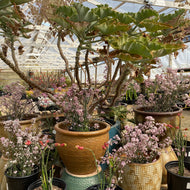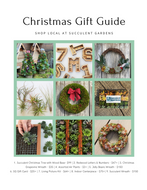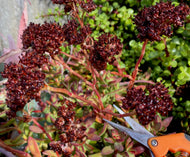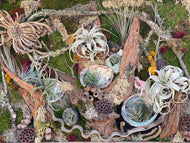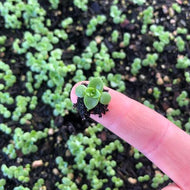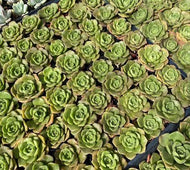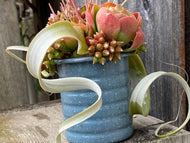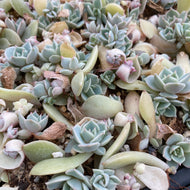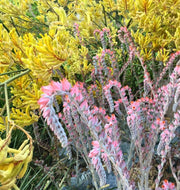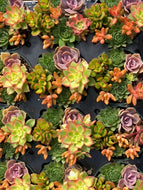Sedum is a large genus of succulent plants with an extremely large distribution throughout North America and Eurasia. With the exception of a few species in Peru, sedums are endemic to regions of the Northern Hemisphere, spanning a wide range of climate zones, from sub-tropical to polar. The genus is comprised of more than 400 species, with still more garden cultivars and hybrids in existence. Sedums are remarkable for their diversity of colors, shapes, and growth habits.
Sedum morganianum
Because of hundreds of thousands of years of geographic separation, the physical characteristics of sedums from one region to the next are remarkably different. The familiar Sedum morganianum (commonly called Donkey Tail Sedum), a species endemic to Eastern Mexico, is a dusty yellow plant with a prostrate, serpent-like growth habit often used in hanging baskets because of its ability to cascade several feet down the side of a container. Sedum cauticola, endemic to alpine regions of Northern Japan, is a grayish-purple plant that produces beautiful magenta flower clusters in summer. These two species look nothing like one another, yet they are very close genetic relatives and classified in the same genus. Apart from physical differences, these two species are likewise very different when it comes to cold tolerance. Due to its geographical distribution in subtropical Mexico, Sedum morganianum can die from exposure to temperatures that fall below 25F. On the other hand, Sedum cauticola, endemic to regions of extreme winter cold, can withstand temperatures well below 0F. This species is amongst a group of alpine sedums that are deciduous, dying back to the ground during their winter dormancy and devoting all of their energy into protecting their root systems from extreme cold. Some taxonomists have re-classified these deciduous types into a separate genus called Hylotelphium, but in the horticultural industry, they for now remain part of the Sedum genus.
Other recognizable Eurasian species include Sedum spectabile (of which ‘Autumn Joy’ is a popular cultivar), Sedum rupestre (‘Angelina’ is one of the most often seen yellow succulent groundcovers), and Sedum spurium, of which there are several cultivars: ‘Dragon’s Blood’, ‘Tricolor’, and ‘Voodoo’ to name a few. In North America, Sedum pachyphyllum, Sedum spathifolium and Sedum x ‘Rubrotinctum’ are a few of many familiar species and hybrids seen in landscapes and often sold in garden centers and nurseries around the world.

Sedum rupestre 'Blue Spruce'
Of all the plants in the succulent world, the genus Sedum is the most widespread. Millions of years of evolution have allowed these wonderful plants to travel far and wide around the globe and find their way into the gardens of countless happy humans.


